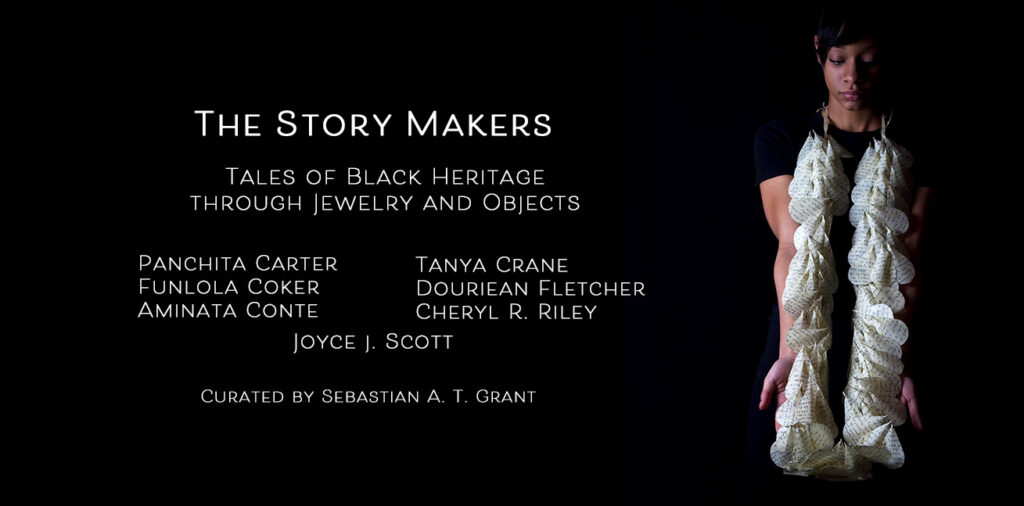The Story Makers | Tales of Black Heritage through Jewelry and Objects

Gallery Loupe is pleased to present The Story Makers, a group exhibition curated by Sebastian A. T. Grant featuring the work of Panchita Carter, Funlola Coker, Aminata Conteh, Tanya Crane, Douriean Fletcher, Cheryl R. Riley, and Joyce J. Scott, seven artists of different generations who have come together to explore their roles as storytellers through jewelry and objects.
Stories contain immense power, recording memory and fostering imagination. In some African tribes, women would take on the role of “storytellers”, weaving epics from thin air to connect to an ancestral tapestry. In the form of folktales, they have been a catalyst for the preservation of African and African-American heritage, one of the major tools to ensure its survival. The works in The Story Makers also display the diverse legacy of the African Diaspora, captured in various craft skills, ideas around materiality, and the different methods each artist uses to tell their story.
Like folktales, craft initiates a legacy, passed down from one generation to the next. This exhibition highlights the importance of craft making for African American women and feminine identifying peoples by exploring the artist’s role as storyteller. The artists in The Story Makers bring their seven separate lives into one single story. The objects they make will explore family and social ties, strength, freedom, equality, and the concept of ‘womanhood’ as we understand it today.
A special installation will feature an example of each artist’s work placed on a central table as if set for dinner. Mealtimes have always been an important locus to engage in conversation; and in fact, many times stories were first told during a meal. Each of these artists tells their story, within this context, and explores how their own tales connect to a greater fabric of African heritage and tradition.
Tanya Crane tells stories of her family, using sgraffito to engage in wider commentaries on the legacy of the Slave Trade, and the present issues of black incarceration. In the piece “What’s His Worth?,” Crane uses the utilitarian object of a urinal to represent the story of her father who passed away at a young age due to paralysis brought on by ALS. The piece represents the degenerative actions of disease that can reduce the body to its most basic functions, just like the urinal. Crane carved tick marks on the surface to represent the amount of time her father spent imprisoned, both in society and in his body.
Cheryl Riley and Aminata Conteh explore the transfer of cultural knowledge through food and cooking practices. In her found object necklaces, Riley uses gilded oxtail bones to commemorate her childhood meals in Houston, Texas, and the special meals that were made by her family. For Conteh, her current sculptural work explores her relationship to her mother through food, carving her recipes into the intricately braided shape of a shekere, an instrument made from the African gourd.
Other stories are expressed in their connection to questions of spirituality, seen in Joyce Scott’s and Douriean Fletcher’s work. Scott uses her famous peyote stitching technique to weave tales of the legacy of Catholicism in Virgin Of Guadalupe, where she depicts the famous Virgin Mary along with images of skeletons and devils, examining the religious concepts of death and mortality captured in Memento Mori. Meanwhile, Fletcher looks to traditional African spirituality, imbuing her work with signs and symbols from the continent to help connect her to her spiritual heritage, severed by the impacts of slavery.
Lastly, Funlola Coker and the late Panchita Carter relate their stories to their careful study of craft and process. Coker engages with West African braiding techniques, long an important role in African hair and basketry practices, and they explore how these links to a past heritage can reveal cultural meaning in cast silver. Carter’s work displays her mastery of silversmithing informed by her multicultural identity of Haitian Creole, Native American, Puerto Rican and Cuban heritage. Through her legacy of teaching and education, Carter imparted her knowledge to a new generation of craftspeople embracing the role of the storyteller.
We invite you to join our opening reception for the exhibition on Saturday, April 5th, 2025 from 3-5 pm, where you will discover more tales created by our artists, the Story Makers.
– Curator, Sebastian A. T. Grant, March 2025